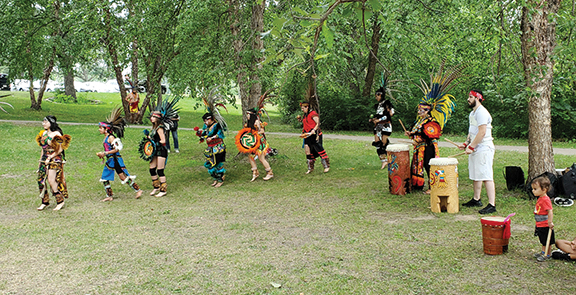
By Lee Egerstrom
At some point late next year, a new Wakan Tipi Center on St. Paul’s East Side will have a grand opening ceremony for a newly constructed site that will help all Minnesotans know and appreciate the thousands of years’ history of the Capitol City and surrounding lands.
Indigenous people’s long presence in and around St. Paul will become more obvious and celebrated. At the same time, the Wakan Tipi Center will continue stressing the importance of the area’s environmental history as well.
The latter provided food, medicine and beauty for early residents and wildlife. It continues to do so in contemporary Mni Sota Makoce, or Minnesota, today.
The construction site for the center has been readied and construction plans are underway, said Executive Director Maggie Lorenz, a Turtle Mountain Band of Ojibwe member and descendant of Spirit Lake Dakota Nation. She heads the nonprofit Wakan Tipi Awanyankapi environmental organization, formerly known as the Lower Phalen Creek Project that has adopted use of the appropriate Dakota name.
Wakan Tipi Awanyankapi in the Dakota language means “those who care for Wakan Tipi.” Wakan Tipi – “dwelling place of the Great Mystery” or the sacred, is the historic name for the sacred cave on St. Paul’s East Side called Carver’s Cave for most of the past 250 years.
While construction for the center gets underway, programs operated by the organization will continue late this fall and into next year. They include programs for Indigenous youth groups and for plant and environment restoration efforts in the Phalen Creek watershed as well as winter storytelling programs, Lorenz said.
The organization concisely states its goal on its website: “Engaging people to honor and care for our natural places and sacred sites and the cultural value within them.”
Attendees at a major summer event, the Pollinator Festival 2023 at Phalen Park in early August, showed how these programs create community bonds stretching from Minnesota’s Indigenous Dakota population to its newest residents.
Recent Hmong and Somali citizens participated in nature walks and other programs. Young Hmong children especially enjoyed dance and drumming by Kalpulli Yaocenoxtli, a traditional Mexica-Nahua (Aztec) cultural group, and cheered on 18-month-old Mateo Salazar, from Richfield, who joined the drum team to keep alive another Indigenous North American cultural tradition.
“It was a fantastic event,” said Jenna Grey Eagle (Pine Ridge Lakota), the environmental justice educator and stewardship coordinator who enjoyed seeing visitors learn about the area’s environment.
One walking tour in Phalen Park had about 100 participants. They learned about acorns, nightshade, milkweed, hoary vervain, and various other plants that the original Dakota residents used and how they can still be utilized for food and medicine.
A second plant walk involved about 70 summer youth program participants who studied native plant species and their ecological and medical benefits. It was led by Wakan Tipi’s Hope Flanagan.
“Our biggest goal with these plant walks is that the general public and the Native community feel inspired to get to know plants more, grow them, and advocate for them,” Grey Eagle said.
The coming year will be busy for Wakan Tipi. Bill Gessner, curator and program director, said as the group will be refining Kindergarten through Grade 12 education resources while it moves into its new center and museum facility.
It will also continue refining a Dakota Lifeways Institute and other public programs. One anchor program, called Gifts of the Plant Nation, will continue online seasonal webinars focusing on an important medical plant each season, he said.
“Winter programming for us will also include the popular Seeds and Snowshoes seeding event.”
This occurs while Wakan Tipi Awanyankapi leaders have worked with many agencies and partners to manage and develop their shared interests.
Among them, there has been the always-necessary task of fundraising.
Lorenz said that since initial grants got programs and planning underway, the group has received another $l million in a grant for the center from the Mellow Foundation in 2002 and $2.5 million this year in bonding from the Minnesota Legislature. That mean Wakan Tipi has raised $13.2 million of the $13.5 million target goal for the project.
In addition, work continues to develop a memorandum of agreement (MOA) for various partners in Wakan Tipi. The land is owned by the St. Paul Parks and Recreation Department, for instance, and an agreement with the city is needed to co-manage that land that is also legally known as the Bruce Vento Nature Sanctuary.
“The goal is to allow for traditional indigenous land stewardship practices at the site, limit use of chemicals and pesticides, and create guidelines for other stewardship groups who work at the site,” she said.
The MOA also needs to outline how Wakan Tipi and the city should engage the federally recognized Dakota tribes in Minnesota for work on the sanctuary land and adjacent Indian Mounds Regional Park. The latter, on the bluffs overlooking downtown St. Paul, the Mississippi River bend, and the historic Kaposia village in what is today South St. Paul, has been a sacred burial grounds for Dakota and other Indigenous tribes through millennia.
The modern history of this geography shows the complexities with which Wakan Tipi’s caring people must work.
The Lower Phalen Creek Project, now known as Wakan Tipi Awanyankapi, was founded by activists in 1999 as a Native-led, East Side (St. Paul) environmental conservation nonprofit. Its program areas stretches from Lake Phalen to the Mississippi River through the East Side River District.
Wakan Tipi Awanyankapi is in reference to the historic and sacred cave known for at least 2,000 years. The colonized name for Wakan Tipi was Carver’s Cave, so named by English explorer Johnathan Carver.
The Bruce Vento Nature Sanctuary was created in 2005 as a St. Paul city park. It involves 29 acres of land on the East Side of downtown St. Paul, along the bluffs above the Mississippi River and by the Wakan Tipi historic cave. It also traces up the Phalen Creek area that has been known over time by multiple names, including Swede Hollow and the Italian East Side.
That organization name is still official. Wakan Tipi is a “doing business as (DBA)” name, said Lorenz. The legal name is in honor of a former St. Paul ‘East Sider,’ the late U.S. Rep. Bruce Vento, who was a key environmentalist member of Congress.
Despite its presence within the city adjacent to the downtown, its unique physical positions allows for natural grasses, prairie and forestry vegetation, and diverse wildlife that include eagles, vultures, hawks and multiple songbirds. It shares terrain with Indian Mounds Regional Park, another sacred site with burial mounds dating back 1,500 to 2,000 years.
Information about Wakan Tipi Center’s progress: https://www.wakantipi.org/wakantipicenter.
Information about the organization’s programs can be found at https://www.wakantipi.org/programs.






